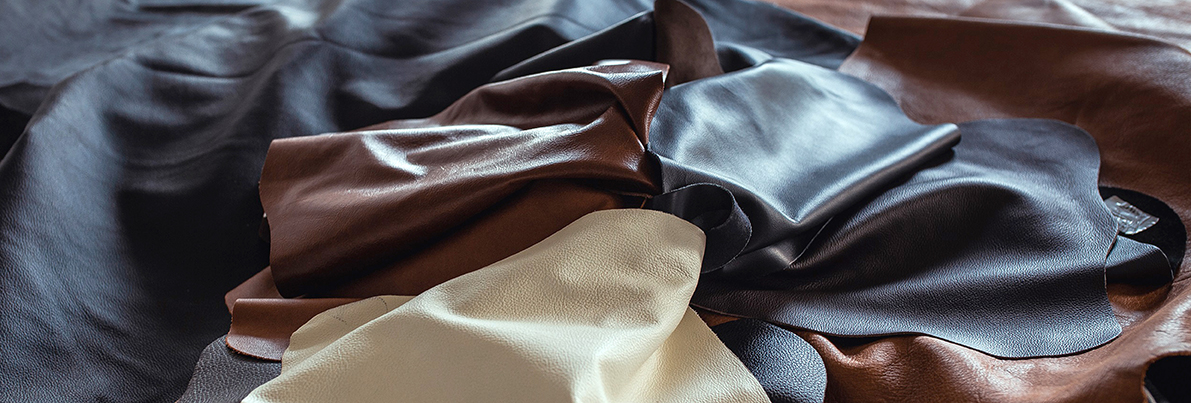Hlavní nabídku tvoří 7 artiklů, které jsme schopni vyrábět v jakýchkoliv barevných odstínech, kromě artiklu Madras DT. Skladové barvy naleznete na našem novém e-shopu. Tyto produkty mohou být zákazníkem osobně vyzvednuty, nebo zavezeny spediční společností. V případě větších odběrů je možné řešit dopravu individuálně s obchodním oddělením.
Prodávané usně z buvola mají 4 m2 a hovězí je v rozmezí 4-6 m2. Odběr u každého artiklu je možný pouze od 1 ks. Skladem držíme 111 barev.
V případě jiného požadavku na odstín je možná výroba po dohodě s obchodním oddělením.
TESTING
We also have a small laboratory for skin testing. Testing involves examining and evaluating the physical properties of the leathers using the abrasion test and the flex test, which are the basic tests that must be performed to determine whether the leather produced meets the physical requirements that are placed on upholstery leathers. Other special tests may also be carried out on manufactured leathers, but these are carried out in specialist laboratories. We can perform these basic tests in our facility. The abrasion test is carried out both dry and using chemical compounds that mimic the action of sweat and water. This test evaluates the abrasion of the felt over the face of the leather. The bending test, or mechanical stress on the leather by breaking, then evaluates the condition of the leather after fifty thousand cycles on a testing machine. This test takes approximately half a day to perform. If cracks or breaks in the leather are detected during the test, the leather must be returned to production and reworked. The same applies if the abrasion test is unsatisfactory. The evaluation of the abrasion test shall take place after the abrasion felt has been attached to the piece of leather being wiped.
PROCESS OF PRODUCTION
Our production process is divided into two production plants (SNAHA, leather cooperative Brtnice and KARO Leather Company s.r.o. with its plant in Boršov u Dušejova). The basic stages of production are carried out in Brtnice, then the leather is transported to Boršov, where the production process is completed, stored and ready for the final customer.
1. Softening
The first stage is the processing of the leather with the Molisa machine, where the softening is carried out mechanically. Each leather must go through this stage to remove hardness, brittleness and shrinkage. The machine is also used in other steps during the production process, always with a view to softening.
2. Plastering
The second stage is the insertion of the leather into the stucco machine by mechanical means, when a certain layer of stucco is applied to the product by means of rollers, which repairs defects and depressions. The leather is then dried in a drying tunnel and at the end of the line it is manually stuccoed, as coarse defects and deep defects must be covered by hand.
3. Grinding
The last production phase that takes place in Brtnice is grinding. The main purpose of grinding is mainly to soften, clean and smooth the slightly damaged face. The products are then transported to the Boršov production plant, where the main part of production continues.
4. Base coat
After the leather has dried in the drying tunnel, the first base coat is applied, which is called the base coat.
5. Design
The next step is the designing of the leather, where each leather is given a characteristic look according to the customer's order. The appearance, or in other words the pattern, is pressed into each leather using pressure and temperature after the base layer has been applied.
6. Bowling
This is followed by the softening of the leather, or the imparting of certain tactile and mechanical properties to the leather by beating it in ball barrels to which moisture and certain amounts of special chemicals are added. This process usually takes between eight and twelve hours. It is applied twice in total, after de-skinning and after the final coat of paint has been applied.
7. Final colouring
The paint is applied by machine application, which is again a two-stage process. First, there is a correction process where the paint is applied and dried in drying tunnels. In the next stage, the varnish is applied, the final coat is applied and again drying follows. After the two layers have been applied, the leather is again beaten in ball barrels as a finished product. The length of the beating process always depends on the type and type of article.
8. Ironing
The products go into the ironing machine where certain chemicals are activated to make the leather either shinier or more comfortable to the touch. At the same time, the surface is ironed and any unevenness that has developed in the leather during production is removed.
9. Testing
Once production is complete, the physical properties of the leather are tested and evaluated using the abrasion test and the bend test, which are the basic tests that must be performed to determine whether the leather produced meets all requirements.
10. Selection
The selection workplace evaluates whether the final product meets the customer's specifications, the required quality and also cleans the leather of damaged or unsuitable parts. The product is then transferred to the measuring and storage area of our factory.
11. Storage facilities
The last stage of leather handling before dispatch to customers is the storage of processed leather in the warehouse system. Here, each leather is measured, marked with the surface area and placed in the warehouse.

